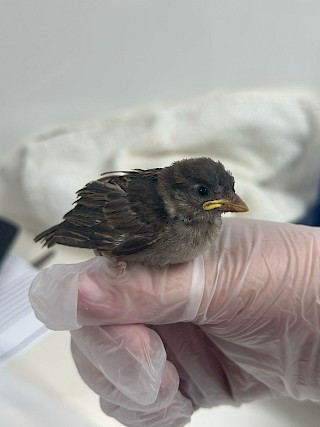Latest News and Events
Warmer weather means the appearance of lots of baby birds - but how do we know when they need help?

The most common type of young bird that we may see out and about at ground level are fledglings. These are young that are old enough to leave the nest but are not yet able to fully fly. Fledglings do typically tend to have all of their feathers and may look similar to the bird pictured (right). Fledglings do leave the nest just before they can fly, so it's normal to see them on the ground and typically, they have their best chance of surviving and making it to adulthood if they remain with their parents. Despite them being on the ground and more vulnerable, their parents will typically be close by and will be helping to feed them and protect them until they are able to fly themselves. This can take a couple of days.
If you see a fledgling in your garden, it is important to keep your distance and monitor them. In doing this, sooner or later you will likely see their parents come to feed them and they will continue to do this periodically. It is ideal to keep any pets away from the fledgling just to prevent any injury and to prevent frightening the parents away.
If you have already removed the fledgling to try and keep them safe, please do not worry as you may still be able to return them so that their parents continue to care for them. This can be done by placing them in a sheltered spot close to where you found them and monitoring for the parents return.
If you find a fledgling that has visable injuries, then this situation needs a different approach as the bird may need veterinary intervention. In this circumstance it is important to seek advice from a vets or wildlife rescue who can advise as to the best way to help the fledgling. You can always contact us for advice on 01706 861897 and we will do our best to advise on the situation at hand.
The other type of young bird you may come across is a nestling. Nestlings are inherently more vulnerable as these are birds that should still be within their nest. They are highly dependent on their parents and tend to have no feathers. They may even have their eyes closed and they won't survive long outside of their nest environment. If you come across a nestling and you can't see a nest in the surrounding trees, or you can see the nest but it has been damaged, then one way you can try to help these babies is by making a replacement nest to put the nestling(s) back into. This replacement nest could be as simple as a basket or plant pot with some nesting material inside that can be secured to the nearest tree. You are then able to monitor for any parents returning from afar.
Again however, if the nestling has injuries, then it is imperative to contact a vets or wildlife rescue for advice as in this situation, intervention may be needed.
The main RSPCA website has a wealth of information surrounding birds that is free to access, and you can see more here: Birds | Wildlife Advice | RSPCA - RSPCA - rspca.org.uk
Published: 8 June 2025


